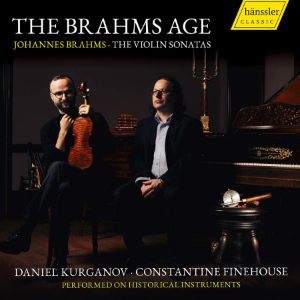
Johannes Brahms (1833-1897)
The Brahms Age
Violin Sonata No. 1 in G major, Op. 78 (1878)
Violin Sonata No. 2 in A major, Op. 100 (1886)
Violin Sonata No. 3 in D minor, Op. 108 (1886-88)
Daniel Kurganov (violin)
Constantine Finehouse (piano)
rec. 2020, Ashburnham, &, La Grua Center Stonington, USA
Hänssler Classic HC22081 [68]
Daniel Kurganov and Constantine Finehouse here play Brahms’ set of three violin sonatas on period instruments. Kurganov plays a Guarnerius (1706) fitted with gut strings throughout; Finehouse plays a J.B. Streicher piano (1868) for the first two sonatas and a Chickering concert grand piano (1886) in the third.
These are glorious works, examples of traditional romantic violin sonatas all composed within a decade, 1878-88. I fondly recall attending a recital in 2004 in the Bridgewater Hall, Manchester, by renowned soloist Maxim Vengerov admirably playing all three these sonatas plus the Scherzo: F.A.E. sonata.
By 1878, Brahms’ Second Symphony had just received its premiere in Vienna conducted by Hans Richter; that same year, Brahms completed his violin concerto for Joseph Joachim and also his first violin sonata in G major, written during his summer holidays in Pörtschach by Lake Wörthersee in the Carinthia region of Austria. The sonata is gloriously songful and expressive;, almost immediately noticeable are the melodic elements and the paradisical, Arcadian character of the score. Not given to exaggeration, the duo convey the melancholy of the Adagio with its gradual increase in anxiety quite splendidly, but although it is bright and breezy the Finale: Allegro might have come across with a more carefree disposition.
During the summer of 1886 Brahms was holidaying close to the Swiss holiday resort of Hofstetten, a small town close to Lake Thun. Finding himself refreshed and musically invigorated, he declared the resort to be ‘so full of melodies that one has to be careful not to step on any.’ In fact, during his three summers at Hofstetten, Brahms composed several of his best-loved chamber works in a short space of time: the second cello sonata, Op. 99, the C minor piano trio, Op. 101, this second violin sonata, sometimes known as the Thun, and the third violin sonata plus a number of Lieder. Probably the most immediately appealing of the three sonatas, this A major score has a radiant, joyful mood and long-spun, heartwarming melodies that are memorable and pleasing on the ear. Kurganov and Finehouse undoubtedly relish the idyllic nature of the score, providing playing which is warm, stylish and assured. Standing out is the duo’s performance of the lively and vibrant Finale: Allegretto grazioso where sections of dark-tinged undertow provide contrast.
In 1888 Brahms dedicated the completed score of the third sonata to his friend and close contemporary Hans von Bülow, a virtuoso pianist renowned for his conducting. This powerful and darkly-coloured D minor score contains significant emotional drama. Unlike the three-movement first and second sonatas the third is in four movements; it is a heavier, more intense work, so Finehouse has chosen to play the larger and more powerful Chickering concert grand piano (1886). In the opening movement Allegro Kurganov and he creates a sense of restlessness and storm which equates well with the oft made comparison to the German Romantic era paintings by Caspar David Friedrich and his vision of the grandeur of the natural world. Especially enjoyable is the emotionally sensitive Adagio, here given a heartfelt performance by the duo which combines calm with a sense of weariness. Conspicuous too is the Finale: Presto agitato in which Kurganov and Finehouse acknowledge the intense passions of the movement with fiery playing of real energy.
Other recordings of the Brahms violin sonatas often include the Scherzo movement in C minor from the F.A.E. sonata (1853) part of a collaborative work between Brahms, Robert Schumann and Albert Dietrich dedicated to the great Hungarian violinist Joseph Joachim. The acronym F.A.E. stands for Frei aber einsam (Free but lonely) which was Joachim’s motto. It’s a fine, if not essential, work, yet I am rather surprised that Kurganov and Finehouse decided not to include it here.
The recording venue for the first two sonatas using the Frederick Historic Piano Collection is Ashburnham, MA and for the third sonata it is La Grua Center Stonington, CT. This set of period instruments have been successfully recorded and I especially enjoy the tone of the Guarnerius violin while the Chickering concert grand sounds magnificent, too. The booklet essays focus in detail on the period instruments played here, but say nothing about the three sonatas themselves.
Compared to modern instruments Kurganov concedes that with ‘the equipment of the era, evenness, projection and broadness of sound were not the highest values.’ On balance, I favour modern instrument performances of Brahms and my first-choice recording reflects that: the Shlomo Mintz (violin) and Itamar Golan (piano) recorded 2003-07 at Teldex Studio, Berlin. In my review I describe the performances on Avie of nos. 1 and 2 by Mintz and Golan as ‘having a clear meeting of minds’. For the third sonata in D minor, it is worth hearing the account from violinist Patricia Kopatchinskaja and pianist Fazil Say on Alpha Classic, recorded in 2022 at Teldex Studio, Berlin (review). I find their playing both idiosyncratic and compelling, if a touch too furious at times.
Hearing Brahms performed on period instruments is always fascinating and these accounts from Kurganov and Finehouse are splendid.
Michael Cookson
Help us financially by purchasing from



Instruments:
Daniel Kurganov:
For all three sonatas: violin, a Joseph Guarnerius filius Andrea of Cremona (1706); fitted with Aquila Corde whole unsplit lamb gut strings.
Constantine Finehouse:
Piano for 1st and 2nd sonatas is a Johann Baptist Streicher of Vienna (1868).
Piano for 3rd sonata is a Chickering & Sons of Boston, MA, USA overstrung concert grand (1886).

















